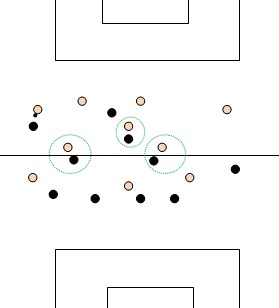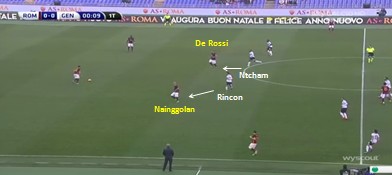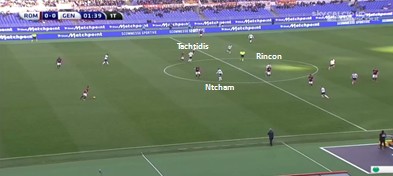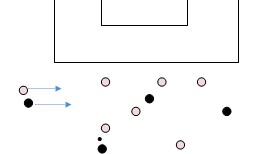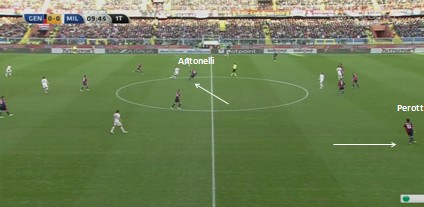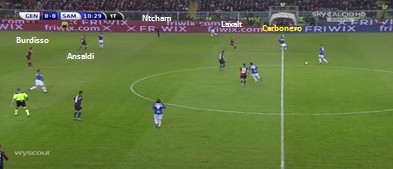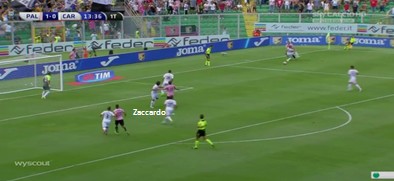Táctica / Conceptos tácticos / English
Man-to-man marking
Man-to-man marking is a defensive strategy where defenders are assigned an opposition player to mark rather than to cover a specific area of the field. Man coverage was the most utilized defensive weapon by teams between the ‘20s and ‘60s. While this system quickly disappeared in South America, it still remained largely used by some of the best European teams through the ‘70s.
With the rise of zonal marking in the ‘80s, man marking is virtually disappeared at top level. So, does it still make sense to talk about man marking in modern football? First and foremost, we are not talking about man-to-man making on set pieces. That’s a way many big teams still utilize to defend at corners and free kicks. We are arguing about man marking in open play. There is a big difference between man marking at set pieces and man marking in open play.
In a rigid way, man marking in open play means each player has the task to chase an opposing player and mark him, following this guy wherever he goes. Rather than trying to cover a specific zone, a player take order to pick up a specific player, which is theoretically easier to do.
Again the idea that man marking is an old schooled, foreign idea to the modern football, you should know that Louis Van Gaal successfully used it at 2014 World Cup. You had to pay attention to the way Dutch gaffer used it asking to his 3-5-2 central midfielders to man marking their opponents through the World Cup campaign. The idea was to put big and constant pressure upon the opponent while blocking their playmakers and their passing lines through the midfield.
That said, not all man-marking are the same. Basically, you can have a rigid man-marking and a more flexible one. A rigid man-to-man marking is a marking in which every player strictly follows his opponent throughout the game wherever he opts to go.
The idea behind this approach is to give each player custody of a specific opponent through the 90 minutes. Helenio Herrera’s well known Catenaccio was a football strategy that employed a very tight man-marking. Often wrongly referred to a negative ‘parking the bus’, Catenaccio changed the face of the game.
Italy national team too, the 1982 FIFA World Cup winner, built a legacy adopting this kind of coverage: defender Claudio Gentile set a high with his marking of Diego Maradona and Azzurri destroyed Brazilian Jogo Bonito through the man marking of the same Gentile on Zico. Gentile marked both Maradona and Zico so effectively that you forget they was on the field. The same happened during the final against West Germany, in which Giuseppe Bergomi, Gentile and Fulvio Collovati man marked, and nullified, Karl-Heinz Rummenigge, Pierre Littbarski and Klaus Fischer. Is the same concept that make the Qb spy, i.e. the linebacker charged with the duty to to keep an eye on a particularly mobile quarterback.
Instead, in a flexible man marking every designed player is asked to man mark the opponent placed on his own zone when the action begins. The logic behind this idea is to retain a defensive balance without being dragged away from designed areas when opponents start switching their positions. This is a more space-oriented man marking, It means that an opponent will be man-marked when he will stay in a specific zone. It’s a compromise between the idea to nullify an opponent and to retain a compact space-coverage. A good example is when a centre-back man-marks a forward moving behind to receive the ball.
Obviously, the weaknesses due to the opponent’s option to drag our players away from important areas to open space still remains. That’s happened during the game between Germany and Holland at EURO 2012, in which Deutsch No. 10 Mesut Ozil drifted out to wide dragging the defensive midfielders, creating space for the upcoming Bastian Schweinsteiger. By the way, every defensive system has its strength and weakness.
DEFENSIVE MAN MARKING
Modern man marking doesn’t concern just midfield. In fact, you still can see it operating on the backline. Genoa currently practice this style. Their coach, Gian Piero Gasperini, is a strong believer in a proactive defensive identity. Indeed, is van Gaal’s philosophy that informed Gasperini’s approach. Studying the Dutchman convinced Gasperini to adopt such style. Gasperini’s defensive approach is build around tackling, intercepting and reading of the game
“I can play three, four or even nine at the back. What counts is the players’ reading and anticipation of the play, which no one does anymore.”
Gian Piero Gasperini
Gasperini won’t his side to sit back. They have to play aggressively. It means defending by running forward through a man marking system. Some teams have often used situational man-marking, as Bayern did. But few team plays this it continuously as Genoa do. Another example comes from coaches asking their fullbacks to follow the opponent’s wingers movement when they cut inside.
Another good example of defensive man marking came when the offensive team is close to cross the ball inside the box. In fact, although some teams opt to retain their zonal marking through the building of a negative diagonal some other favor a man-to-man marking in which the defenders are instructed to closely follow the man found in their zone when the ball is in a crossing zone.
CONCLUSION
Focusing upon the opponent’s movements is an interesting tactic and not an old schooled one yet. As a defense marks their opponents they are defending against them rather than controlling the space. People usually define “proactive” defensive systems which don’t change team’s defensive structure. That’s not completely correct. A “proactive” defensive system is a system that force opponents to change their offensive structure. Most defenses simply sit back trying to contain the opposite offense, but don’t look to change their offensive structure in favor of their own defense. An “active” offense is one that should force the offense out from its comfort zone. Pressing correctly is a good way to force the rivals to alter their offensive stability. But that’s not the only way to drag offenses outside their comfort zone. Man marking isn’t to be thought just as a way to passively adapt a defense to an offense. That’s also a way to get offenses out of rhythm, disrupting their synchronism.
* Michele Tossani is a football analyst.
Follow @ArrigoSacchi442

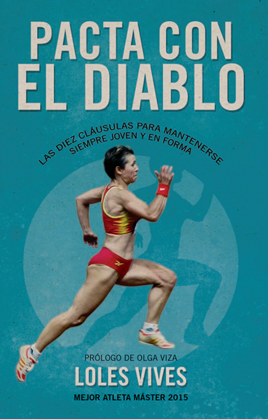
BUSCADOR DE CATEGORÍAS
BUSCADOR POR MES
ÚLTIMOS TWEETS
Tweets por @martiperarnauSÍGUENOS EN FACEBOOK




